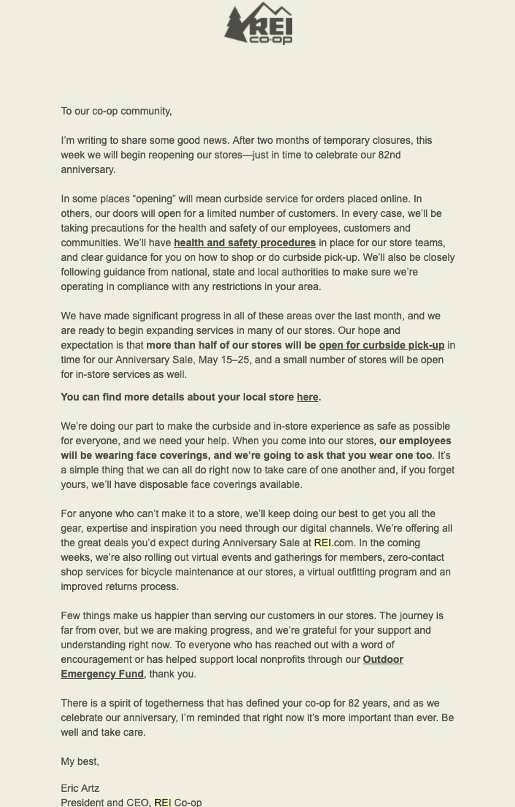Originally published on May 14, 2020
“In preparing for battle I have always found that plans are useless, but planning is indispensable.” – Dwight D. Eisenhower
Just three short months ago (or long depending upon your perspective) who could have envisioned that we’d be where we are right now?
The S&P, Dow, and NASDAQ were trading at all-time highs, the unemployment rate was the lowest in sixty years, consensus estimates for Q1-20 GDP were in the 2.0% +/- range, consumer sentiment was the highest (excepting one blip in 2004) it had been in twenty years and the supply of toilet paper and Clorox wipes was plentiful.
Fast forward to today… things are very different.
When the reality of the crisis began to ripple through US businesses and reverberate across global markets back in early-to-mid March, we experienced many businesses (large and small) activating their crisis communications plans.
The playbook for crisis communications is pretty well understood:
- Stay on Brand
- Own it if your Brand created the problem
- Get out with messaging quickly
- Centralize and standardize communications and responses to inquires
- Monitor reactions and responses closely
- Provide accurate and clear updates regularly
Most of us received eMails from a variety of businesses early on acknowledging the unprecedented situation, letting us know what they were doing to maintain business continuity (to the extent they were allowed) and reiterating how much they valued us either as customers (B2B and B2C) or suppliers, and in some circumstances, demonstrating some real empathy by outlining things they were doing to help their customers out during these trying times.
In my opinion, one of the best examples of getting out with a genuine, empathetic, on-brand, no fluff message was Arne Sorenson’s (President & CEO of Marriott) video message to Marriott’s employees. NOTE: If you haven’t seen this video already, do yourself a favor and carve out five minutes of your day for this.
By the week of March 22nd, we began to see TV commercials spring up with some variation of a “we’re in this together” message. And by early April, it seemed that every Brand (as my friends at Ace Metrix will attest) had finally gotten on the bandwagon, hired the same team of writers and produced their amazingly similar version of an “in these unprecedented times, we’re here for you” ad.
Here we are now in mid-May, states and metro areas are beginning to allow some businesses to re-open; while some are still discussing, debating or rethinking it. Many (business owners, the general public as well as the media it seems) are unclear about what it means to be open, what businesses are allowed to be open, under what conditions businesses are allowed to be open, and most importantly, what does that mean for us as customers? But have you noticed any new (non-promotional) communications from businesses to provide updates on their plans for reopening?
What got me thinking about this was a marketing eMail I received penned by the CEO of REI earlier this week outlining their store-reopening plans and protocols. This is the first and only eMail I’ve received so far from any Brand explaining what “reopening” means in their world, what operational / hygiene changes they’ve made and most importantly, what this all means for me as their customer.

And this brings me back to the last bullet point from the crisis communications playbook as well as the Eisenhower quote.
One of the critical steps in a crisis communication plan is to regularly provide clear and accurate updates. And it seems to me that many brands have fallen short on this – possibly due to the unprecedented nature of the COVID-19 crisis. That is, they’d rather not communicate anything at all until they themselves are completely clear on what things will look like as they go forward. (Note also that this is different from ongoing marketing and promotional communications which don’t seem to have dropped off much based on my daily inbox.)
But radio silence is exactly the wrong thing for organizations to be doing right now because consumers are looking to Brands to help lead all of us out of this mess. And if you are leaving a communications void, you’re creating an opportunity for one of your competitors to fill it.
I will stipulate that most organizations do have reasonably well-defined crisis communications plans; however I suspect most of these plans were designed to deal with situations that are generally isolated to their brand, industry sector and customers – and there have been plenty of examples for brands to learn from (both good and bad). These plans also likely contemplate things returning to some level of normalcy.
However, our current crisis broke the mold in that it has literally affected everyone. We’re essentially experiencing the proverbial Martian attack. And, I suspect most organizations haven’t spent much (if any) time preparing their Martin attack (or something as absurd as a global pandemic crisis that requires everyone to “stay-at-home”) communication plan.
Right now, many organizations are looking at the prospects of things possibly never returning back to normal, and they’re not sure what, if anything they should say, and this is the point Eisenhower was making.
Planning is indispensable…
It’s not likely that anyone could have envisioned the exact scenario we’re all experiencing right now. I would however argue that it is possible to develop a crisis communications framework to deal with an extreme situation where things don’t return to normal. That is, if an organization took the time to do it.
The point isn’t to have an exact plan ready for every possible situation; but rather developing the organizational capabilities that will allow your Brand to successfully navigate a range of unforeseen situations – in the event that they do arise.
Just the other day, I was on a conference call, and one of the participants commented that they felt they’d already experienced enough “life-changing” crisis at this point in their life. They stated they could vividly remember the dot-com bubble, 9-11, the Great Recession and now the COVID-19 pandemic. That’s four fairly extreme crisis in just the past twenty years.
Perhaps preparing your Brand (by planning) to communicate throughout an extreme crisis, where things don’t return to normal, might not be an extreme idea after all?


Leave a Reply